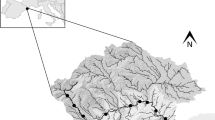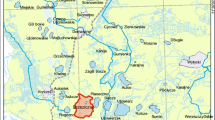Abstract
Sediment organic matter content, bulk density, and hydraulic conductivity were examined in 56 sediment cores collected from a small lotic wetland in the Talladega Wetland Ecosystem (Hale County, Alabama, USA). All sediment characteristics varied spatially across the wetland. A distinctive demarcation in sediment characteristics occurred between the upper (0 to 30-cm) and lower (30 to 80-cm) depths. Sediments in the upper 30-cm contained a higher percentage of clay than deeper sediments and had high hydraulic conductivities (0.5 to 1100 cm d−1). Lower sediment depths contained greater percentages of silt and sand, but greater sediment compaction and lower organic matter concentrations resulted in low hydraulic conductivities (1 × 10−3 to 55 cm d−1). Higher organic matter and lower bulk density occurred in the sediments of vegetated areas of the wetland compared to the areas near the inflow and outflow streams. Organic matter was higher and more variable (2 to 38% sediment dry weight) within the upper 30 cm of sediments and decreased significantly with depth (r2 = 0.51). In the lower sediments (30 to 80-cm depth), organic matter was lower and less variable (2 to 10% sediment dry weight). Sediment bulk density increased with increased sediment depth (r2 = 0.77) and was lower in vegetated areas (0.2 to 1.0 g cm−3) compared to the inflow and outflow stream sediments (0.6 to 1.4 g cm−3).
Similar content being viewed by others
Literature Cited
Carter, S., G. M. Ward, R. G. Wetzel, and A. C. Benke. 2000. Growth, production, and senescence of Nymphaea odorata Aiton in a southeastern (U.S.A.) wetland. Aquatic Botany (In review).
Crownover, S. H., N. B. Comerford, D. G. Neary, and J. Montgomery. 1995. Horizontal groundwater flow patterns through a cypress swamp-pine flatwoods landscape. Soil Science Society of America Journal 59:1199–1206.
Fetter, C. W. 1994. Applied Hydrogeology. 3rd ed. Prentice Hall, Englewood Cliffs, NJ, USA.
Fiebig, D. M. 1995. Groundwater discharge and its contribution of dissolved organic carbon to an upland stream. Archiv für Hydrobiologie 134: 129–155.
Gee, G. W. and J. W. Bauder. 1986. Particle-size analysis. p. 383–411. In A. Klute (ed.) Methods of Soil Analysis, Part 1. 2nd ed. Agronomy Monograph no. 9. ASA and SSSA, Madison, WI, USA.
Godshalk, G. L. and R. G. Wetzel. 1978. Decomposition of aquatic angiosperms. II. Particulate components. Aquatic Botany 5:301–327.
Harvey, J. W., R. M. Chambers, and J. R. Hoelscher. 1995. Preferential flow and segregation of porewater solutes in wetland sediments. Estuaries 18:568–578.
Jones, J. B., S. G. Fisher, and N. B. Grimm. 1995. Nitrification in the hyporheic zone of a desert stream ecosystem. Journal of the North American Benthological Society 14:249–258.
Jones, J. B., R. M. Holmes, S. G. Fisher, and N. B. Grimm. 1994. Chemoautotrophic production and respiration in the hyporheic zone of a Sonoran desert stream. p. 329–338. In J. A. Stanford and H. M. Valett (eds.). Proceedings of the Second International Conference on Ground Water Ecology. American Water Resources Association, Herndon, VA, USA.
Mann, C. J. and R. G. Wetzel. 1995. Dissolved organic carbon and its utilization in a riverine wetland ecosystem. Biogeochemistry 31:99–120.
Mann, C. J. and R. G. Wetzel. 1998. Photosynthesis and stomatal conductance of Juncus effusus in a temperate wetland ecosystem Aquatic Botany 63:127–144.
Mann, C. J. and R. G. Wetzel. 2000. Hydrology of an impounded lotic wetland—subsurface hydrology. Wetlands, 20:33–47.
Mitchell, A. R., T. R. Ellsworth, and B. D. Meek. 1995. Effect of root systems on preferential flow in swelling soil. Communication in Soil Science and Plant Analyses 26:2655–2666.
Romanov, V. V. 1968. Hydrophysics of Bogs, translated from Russian by N. Kaner and edited by Prof. Heimann, Israel Program for Scientific Translation, Jerusalem, Israel.
Stanley, E. H. and A. K. Ward. 1997. Inorganic nitrogen regimes in an Alabama wetland. Journal of the North American Benthological Society 16:820–832.
Wetzel, R. G. 1990. Detritus, macrophytes and nutrient cycling in lakes. In R. de Bernardi, G. Giussani and L. Barbanti (eds.) Scientific Perspectives in Theoretical and Applied Limnology. Memorie dell’Istituto Italiano di Idrobiologia 47:233–249.
Wetzel, R. G. and M. J. Howe. 1999. Maximizing production in a herbaceous perennial aquatic plant by continuous growth and synchronizing population dynamics. Aquatic Botany 64:111–129.
Author information
Authors and Affiliations
Corresponding author
Rights and permissions
About this article
Cite this article
Mann, C.J., Wetzel, R.G. Hydrology of an impounded lotic wetland—wetland sediment characteristics. Wetlands 20, 23–32 (2000). https://doi.org/10.1672/0277-5212(2000)020[0023:HOAILW]2.0.CO;2
Received:
Revised:
Accepted:
Issue Date:
DOI: https://doi.org/10.1672/0277-5212(2000)020[0023:HOAILW]2.0.CO;2




